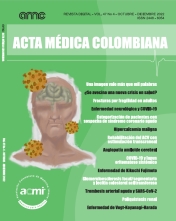Classification of patients with suspected acute coronary syndrome according to the universal definition
Abstract
Objective: to describe the clinical, imaging and laboratory characteristics of patients undergoing coronary arteriography with a presumptive diagnosis of acute coronary syndrome between January 2017 and December 2019, as well as the frequencies of the types of infarction according to the universal definition.
Methods: an observational, cross-sectional study of patients over the age of 18 undergoing coronary angiography at a university hospital in Bogotá. Statistical analysis was carried out using STATA software, calculating absolute frequencies, proportions, and measures of central tendency and dispersion, according to the behavior of the variables. Patients were classified according to the fourth universal definition of infarction, determining each respective frequency.
Results: a total of 714 medical charts were analyzed, corresponding to 459 men and 255 women, with high blood pressure, dyslipidemia, obesity, diabetes and prior coronary disease being the most common cardiovascular risk factors. Altogether, 68.9% of the patients had an electrocardiogramwith an abnormal reading, and only 43.8% of the patients had obstructive lesions, of whom 33.2% were patients with type I infarction. A 12.2% prevalence was found for type II infarction, and 17% for the MINOCA category. Inpatient mortality was 2.5%, mainly due to cardiogenic shock.
Conclusions: patients with acute coronary syndrome were predominantly males with cardiovascular risk factors. In this study, most patients did not have obstructive lesions on arteriography. However, type I infarction was the most common type.
Metrics
Copyright (c) 2022 Camila Ardila Sabogal

This work is licensed under a Creative Commons Attribution 4.0 International License.
Acta Medica Colombiana uses the CC-BY 4.0 license. Authors retain all rights over their work.


